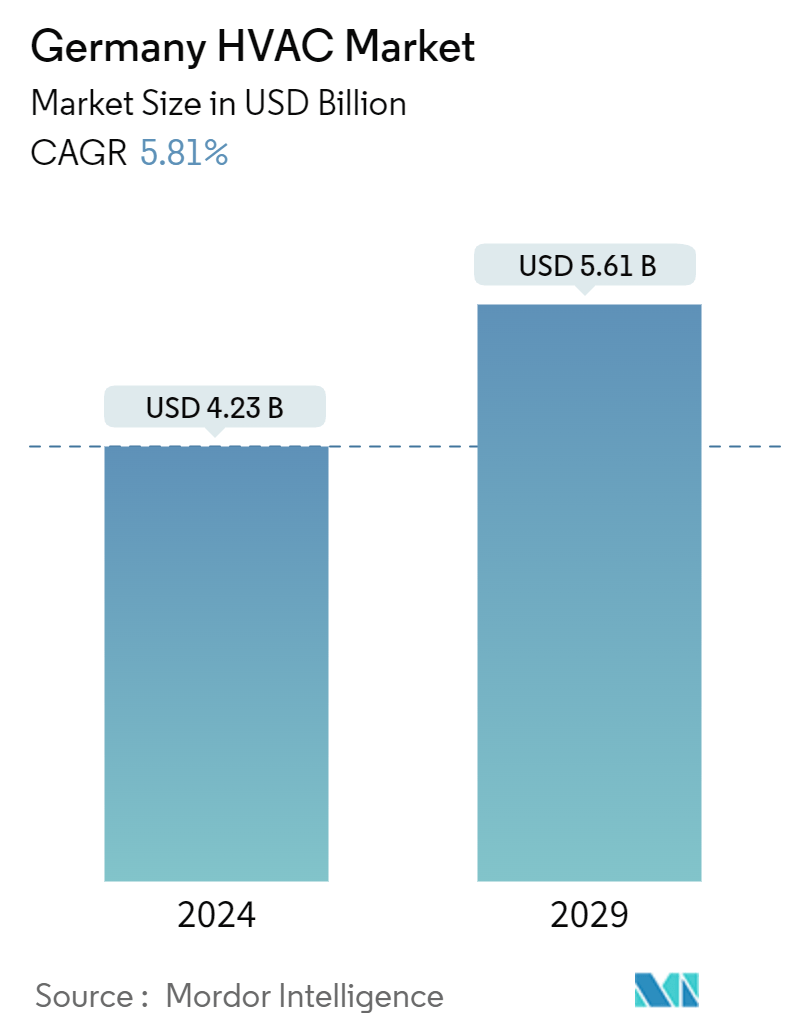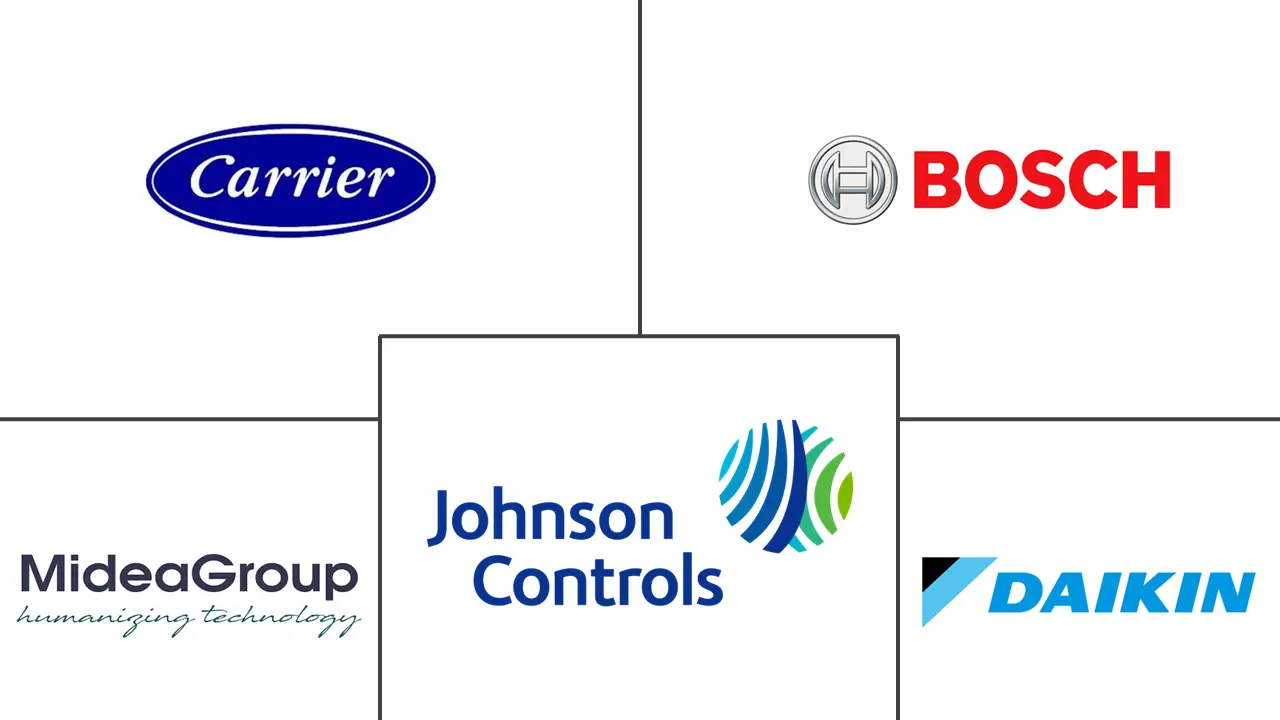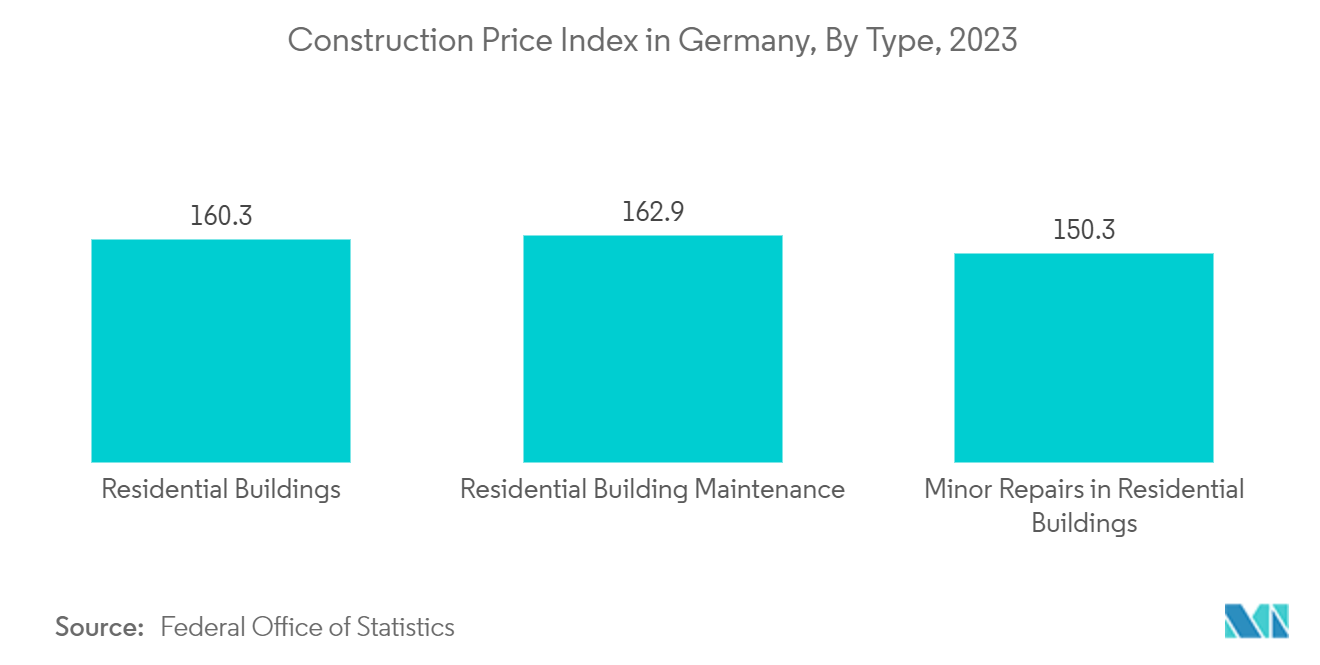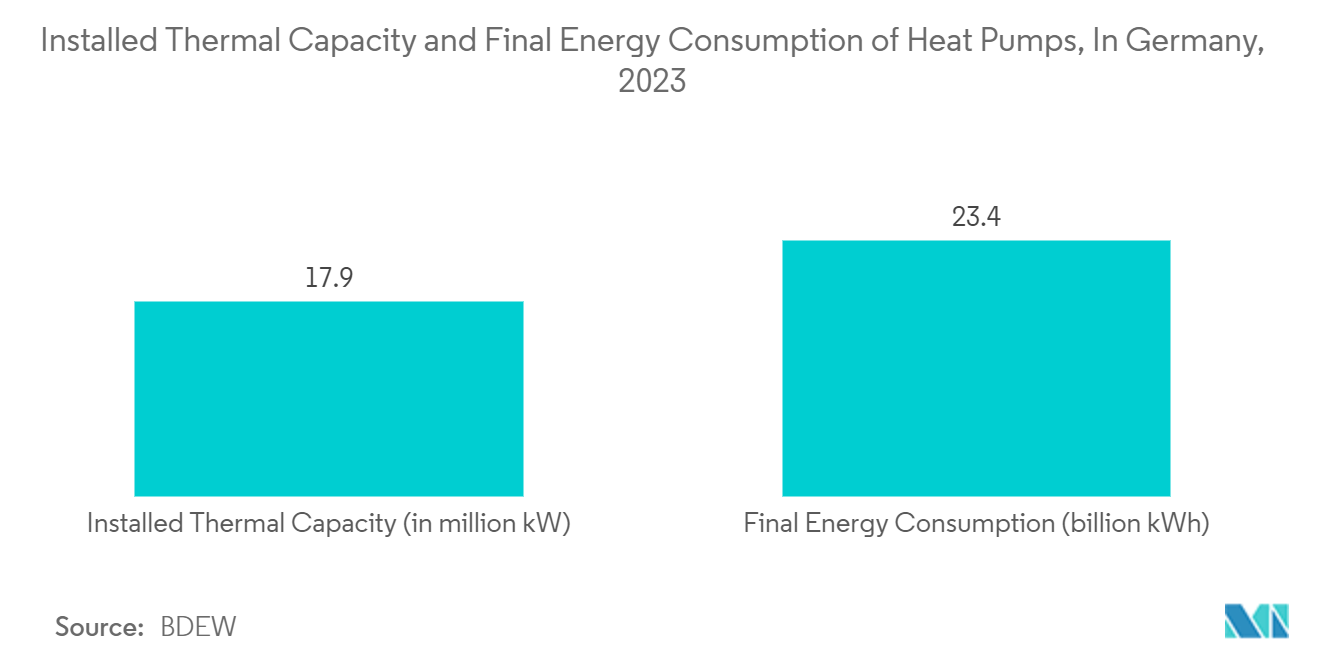Germany HVAC Market Size

| Study Period | 2019 - 2029 |
| Base Year For Estimation | 2023 |
| Market Size (2024) | USD 4.23 Billion |
| Market Size (2029) | USD 5.61 Billion |
| CAGR (2024 - 2029) | 5.81 % |
| Market Concentration | Low |
Major Players
*Disclaimer: Major Players sorted in no particular order |
Germany HVAC Market Analysis
The Germany HVAC Market size is estimated at USD 4.23 billion in 2024, and is expected to reach USD 5.61 billion by 2029, growing at a CAGR of 5.81% during the forecast period (2024-2029).
- The factors contributing to the expansion of the market in Germany being analyzed include the adoption of advanced monitoring systems, smart technologies, and building automation systems, a greater emphasis on cost savings and maintenance, and improved maintenance and personalized services for HVAC systems.
- Already acknowledged as a mature market for energy efficiency and a green economy, Germany is doubling its efforts in energy diversification and introducing regulations and technologies to tackle climate challenges in HVAC and other sectors. For instance, the government has announced that it would cover up to 70% of the costs of new and sustainable heating systems from 2024, which may let people wait with the applications. Thus, increasing government focus on installing energy-efficient HVAC solutions further drives the role of the HVAC market in the country.
- In addition, the subsidy for heat pumps provided by BAFA in Germany is administered by the Federal Office for Economic Affairs and Export Control. It covers up to 50% of the total installation cost, with a maximum of EUR 3,000 for single-family residences and EUR 6,000 for multi-family homes.
- Integrating new HVAC technologies with existing building infrastructure can be complex and expensive. Issues may exist, especially in older buildings, which can deter upgrades. In addition, although rising energy costs drive demand for energy-efficient systems, fluctuating energy prices can also create uncertainty, impacting investment decisions. Dependence on traditional energy sources can slow the transition to more sustainable HVAC solutions, thus hindering the market's growth.
- Macroeconomic factors like government initiatives and subsidies promoting the adoption of energy-efficient HVAC systems play a significant role. Policies like the energy saving ordinance (EnEV) and incentives for green buildings drive the demand for modern, energy-efficient HVAC systems. In addition, programs offering financial incentives for retrofitting old systems with new, efficient ones boost market growth.
Germany HVAC Market Trends
Residential Sector to Hold Significant Market Share
- The country's HVAC systems in residential settings have been growing due to increased demand for energy-efficient heating and cooling systems. Rising energy costs and government incentives for energy-efficient home upgrades drive this growth. For instance, in September 2023, in Germany, newly constructed homes qualified for tax credits, even without stricter efficiency standards. These credits allowed new building projects to offset 6% of the investment costs against taxes in the initial year. The eligibility window spans projects commencing construction between October 1, 2023, and September 30, 2029.
- Germany has introduced regulations to encourage the development of nearly zero-energy buildings, thereby pushing residential structures to enhance energy efficiency by utilizing efficient energy sources like heat pumps. Heat pumps are commonly employed as heat sources in single-family homes and terraced houses, and their usage is also progressively expanding in apartment buildings.
- The KfW regulation for subsidies on HVAC equipment, such as heat pump funding, is designed to support the installation of renewable heat pumps in Germany. The program offers financial support of up to EUR 5,000 for single-family homes and up to EUR 10,000 for multi-family housing. Numerous energy companies in Germany are advocating for the use of heat pumps. The subsidies usually cover up to 50% of the entire installation expenses. Such initiatives by the companies and government in the market are expected to complement the demand growth for HVAC services in the country.
- In 2023, a significant trend emerged in Germany's construction landscape: 75% of newly approved buildings began featuring heat pumps. Out of the total new residential constructions approved, 76% were set to rely predominantly on heat pumps. Furthermore, data reveals that nearly 65% of the approximately 96,800 residential buildings completed in 2023 embraced heat pumps as the primary heating solution.

HVAC Equipment to Hold Significant Market Share
- The increasing effects of global warming are driving the growth of HVAC equipment. This trend is especially pronounced in countries such as Germany, where soaring temperatures require air conditioning.
- Several older buildings in Germany require renovation to meet modern energy standards, leading to increased demand for HVAC retrofitting and upgrades. Government incentives for building renovations and retrofits further stimulate this demand. The country's aging infrastructure necessitates replacement and maintenance services, driving ongoing demand. Regular maintenance requirements to ensure system efficiency and longevity contribute to the demand for HVAC equipment. Presently, approximately half of Germany's buildings rely on gas heating systems.
- For instance, in August 2023, the Building Energy Act (GEG) aimed to incrementally boost the utilization of renewable energy sources for heating in commercial and residential buildings. Under the GEG, all new heating systems must derive at least 65% of the energy from renewable sources, whether in existing or new constructions. Existing systems can remain operational and undergo repairs as needed. Notably, post-2024, the act will allow for the installation of gas heaters, provided they are hydrogen-compatible, allowing for potential conversion in the future.
- Germany offers substantial grants for HVAC equipment like heat pumps. According to EHPA, landowners can receive up to EUR 18,000 for ground-source heat pumps and up to EUR 15,000 for air-source heat pumps. On January 1, 2024, the German government, in collaboration with the BWP, introduced enhanced funding options. Under these new provisions, property owners can now access a maximum subsidy of EUR 21,000 when installing a heat pump. Notably, while these grants are open to all, they are especially advantageous for low-income families.

Germany HVAC Industry Overview
The German HVAC market is fragmented, with the presence of major players like Carrier Corporation, Robert Bosch GmbH, Midea Group Co. Ltd, Johnson Controls International PLC, and Daikin Industries Ltd. Players in the market are adopting strategies such as partnerships, mergers, innovations, investments, and acquisitions to enhance the product offerings and gain sustainable competitive advantage.
- January 2024: Apleona, headquartered in Gerlingen near Stuttgart, Germany, finalized its acquisition of Air for All, a prominent ventilation and air conditioning company. Air for All specializes in cleanrooms and laboratories and caters primarily to clients in the automotive and healthcare sectors. This strategic move bolsters Apleona's technical systems portfolio and significantly enhances its footprint in the lucrative southwest region of Germany.
- October 2023: Vargas Investment Group launched Aira, a direct-to-consumer company that provides heat pumps through a monthly subscription model. Aira debuted in Germany in September, inaugurating a training academy in Berlin. By acquiring Garant Warmesysteme, Aira extended its reach from Berlin-Brandenburg to Saxony and Bavaria in Germany. Aira's ambitious goal is to install heat pumps in 5 million European households within the next decade, with a significant focus on 1 million installations in Germany.
Germany HVAC Market Leaders
-
Carrier Corporation
-
Robert Bosch GmbH
-
Midea Group Co., Ltd.
-
Johnson Controls International PLC
-
Daikin Industries, Ltd.
*Disclaimer: Major Players sorted in no particular order

Germany HVAC Market News
- April 2024: Daikin introduced its latest innovation: the EWT-Q-X-A1 range of water-to-water heat pumps, featuring its signature Daikin design scroll compressors. These advanced heat pumps, sourced from water, offer versatile heating and cooling capabilities. The heat pumps can deliver hot water up to +60°C and provide chilled water ranging from -15°C (with a water-glycol mixture) to +30°C for the evaporator, leaving water temperature.
- April 2024: Johnson Controls introduced its latest residential heat pump series, the York HH8. These heat pumps promise high-tier efficiency and cutting-edge technology, all at a price point typically associated with mid-tier units. Notably, the York HH8 Side-Discharge models are equipped with R-454B refrigerant and are available in sizes ranging from 2 to 5 tons. The system offers a seasonal energy efficiency ratio (SEER) of up to 19 and a heating seasonal performance factor (HSPF) of up to 9.0.
Germany HVAC Market Report - Table of Contents
1. INTRODUCTION
- 1.1 Study Assumption and Market Definition
- 1.2 Scope of the Study
2. RESEARCH METHODOLOGY
3. EXECUTIVE SUMMARY
4. MARKET INSIGHTS
- 4.1 Market Overview
-
4.2 Industry Attractiveness - Porter's Five Forces Analysis
- 4.2.1 Bargaining Power of Suppliers
- 4.2.2 Bargaining Power of Consumers
- 4.2.3 Threat of New Entrants
- 4.2.4 Threat of Substitute Products
- 4.2.5 Intensity of Competitive Rivalry
- 4.3 Industry Value Chain Analysis
- 4.4 Impact of COVID-19 Aftereffects and Other Macroeconomic Factors on the Market
5. MARKET DYNAMICS
-
5.1 Market Drivers
- 5.1.1 Increased Construction and Retrofit Activity to Aid Demand
- 5.1.2 Supportive Government Regulations Including Subsidies, Incentives for Saving Energy through Tax Credit Programs
-
5.2 Market Challenges
- 5.2.1 High Initial Cost of Energy Efficient Systems
- 5.2.2 Shortage of Skilled Labour
6. MARKET SEGMENTATION
-
6.1 By Type of Component
- 6.1.1 HVAC Equipment
- 6.1.1.1 Heating Equipment
- 6.1.1.2 Air Conditioning /Ventilation Equipment
- 6.1.2 HVAC Services
-
6.2 By End-user Industry
- 6.2.1 Residential
- 6.2.2 Commercial
- 6.2.3 Industrial
7. COMPETITIVE LANDSCAPE
-
7.1 Company Profiles*
- 7.1.1 Carrier Corporation
- 7.1.2 Robert Bosch GmbH
- 7.1.3 Midea Group Co. Ltd
- 7.1.4 Johnson Controls International PLC
- 7.1.5 Daikin Industries Ltd
- 7.1.6 System Air AB
- 7.1.7 LG Electronics Inc.
- 7.1.8 Mitsubishi Electric Hydronics & IT Cooling Systems SpA
- 7.1.9 Flaktgroup Inc.
- 7.1.10 Danfoss Inc.
8. INVESTMENT ANALYSIS
9. FUTURE OF THE MARKET
** Subject To AvailablityGermany HVAC Industry Segmentation
HVAC systems, short for heating, ventilation, and air conditioning, are designed to regulate temperature and humidity, ensuring comfortable environmental conditions and delivering clean air in buildings. They comprise various components, including boilers, furnaces, refrigerators, humidifiers, and heat pumps.
The study tracks the revenue accrued through the sale of HVAC products in residential, commercial, industrial sector by various players in Germany. The study also tracks the key market parameters, underlying growth influencers, and major vendors operating in the industry, which supports the market estimations and growth rates over the forecast period. The study further analyses the overall impact of COVID-19 aftereffects and other macroeconomic factors on the market. The report's scope encompasses market sizing and forecasts for the various market segments.
The German HVAC market is segmented by type of component (HVAC equipment [heating equipment and air conditioning/ventilation equipment] and HVAC services), and end-user industry (residential, commercial, and industrial). The market sizes and forecasts are provided in value (USD) for all the above segments.
| By Type of Component | HVAC Equipment | Heating Equipment |
| Air Conditioning /Ventilation Equipment | ||
| By Type of Component | HVAC Services | |
| By End-user Industry | Residential | |
| Commercial | ||
| Industrial |
Germany HVAC Market Research FAQs
How big is the Germany HVAC Market?
The Germany HVAC Market size is expected to reach USD 4.23 billion in 2024 and grow at a CAGR of 5.81% to reach USD 5.61 billion by 2029.
What is the current Germany HVAC Market size?
In 2024, the Germany HVAC Market size is expected to reach USD 4.23 billion.
Who are the key players in Germany HVAC Market?
Carrier Corporation, Robert Bosch GmbH, Midea Group Co., Ltd., Johnson Controls International PLC and Daikin Industries, Ltd. are the major companies operating in the Germany HVAC Market.
What years does this Germany HVAC Market cover, and what was the market size in 2023?
In 2023, the Germany HVAC Market size was estimated at USD 3.98 billion. The report covers the Germany HVAC Market historical market size for years: 2019, 2020, 2021, 2022 and 2023. The report also forecasts the Germany HVAC Market size for years: 2024, 2025, 2026, 2027, 2028 and 2029.
Germany HVAC Industry Report
Statistics for the 2024 Germany HVAC market share, size and revenue growth rate, created by Mordor Intelligence™ Industry Reports. Germany HVAC analysis includes a market forecast outlook for 2024 to 2029 and historical overview. Get a sample of this industry analysis as a free report PDF download.



